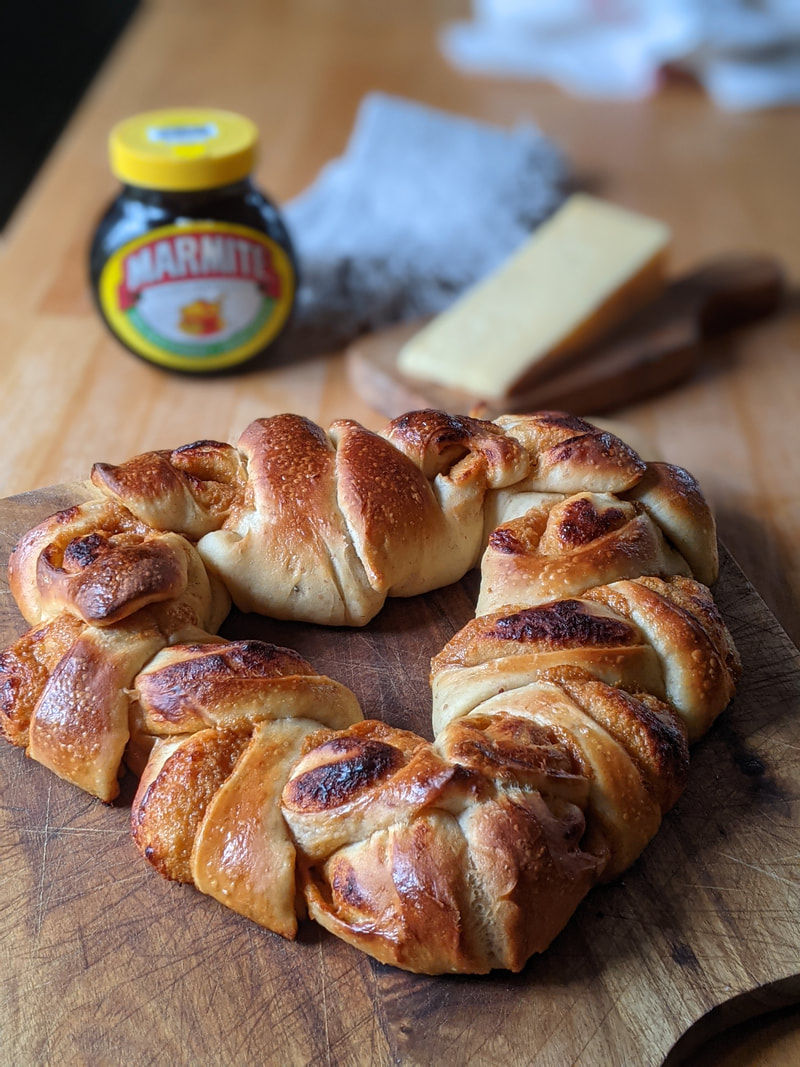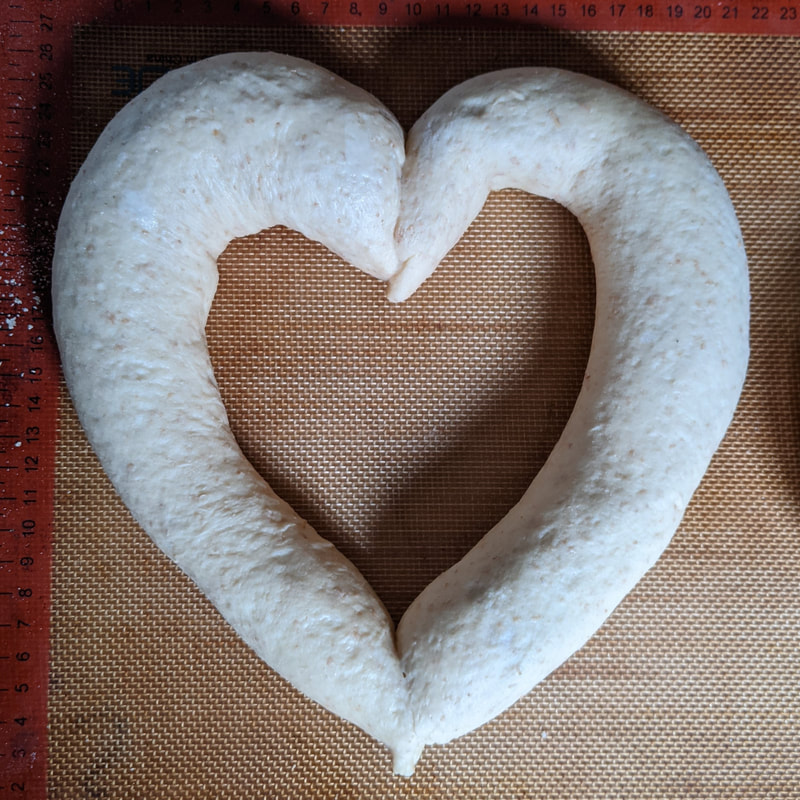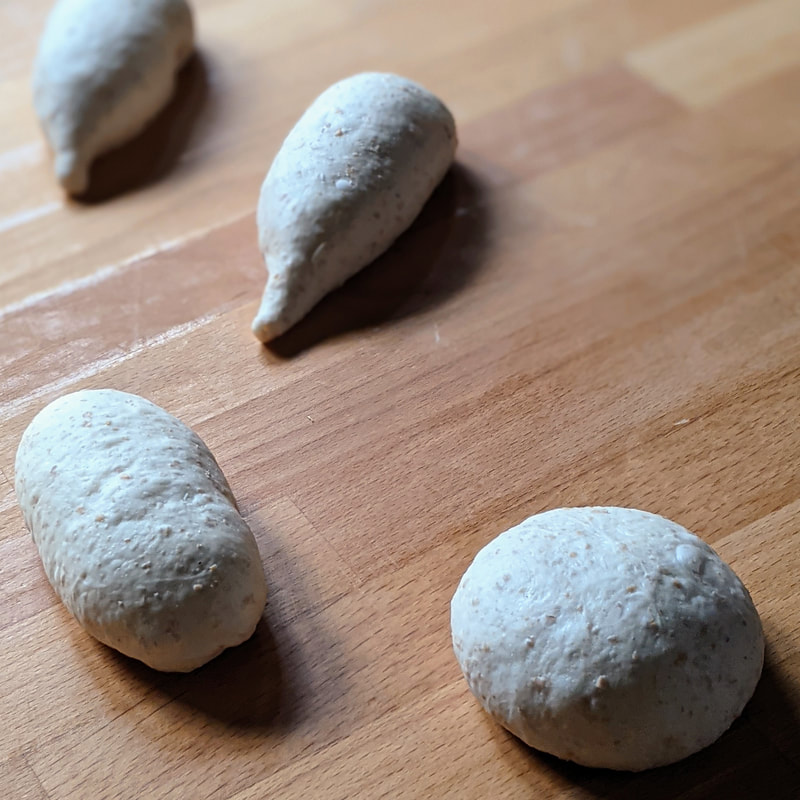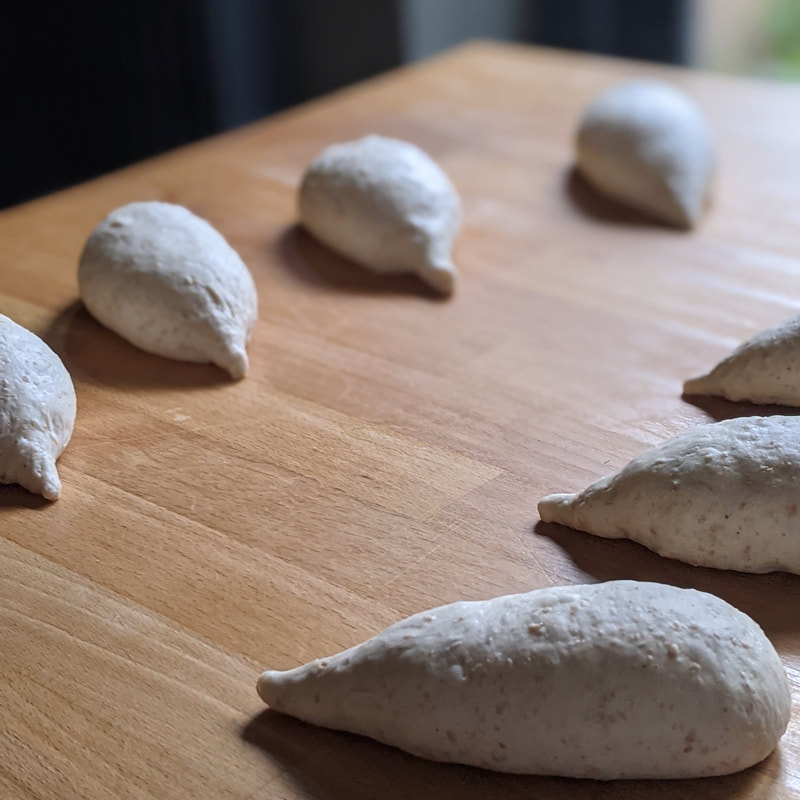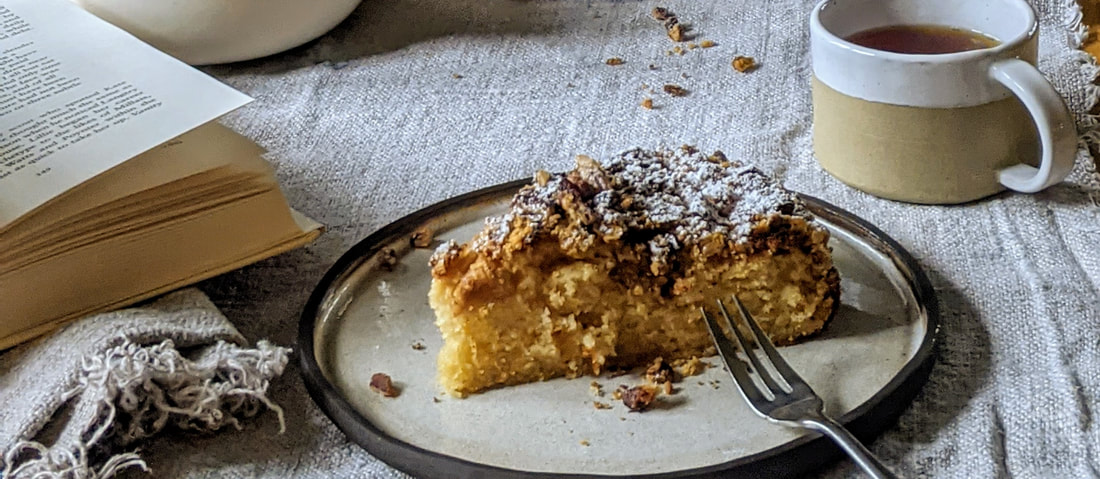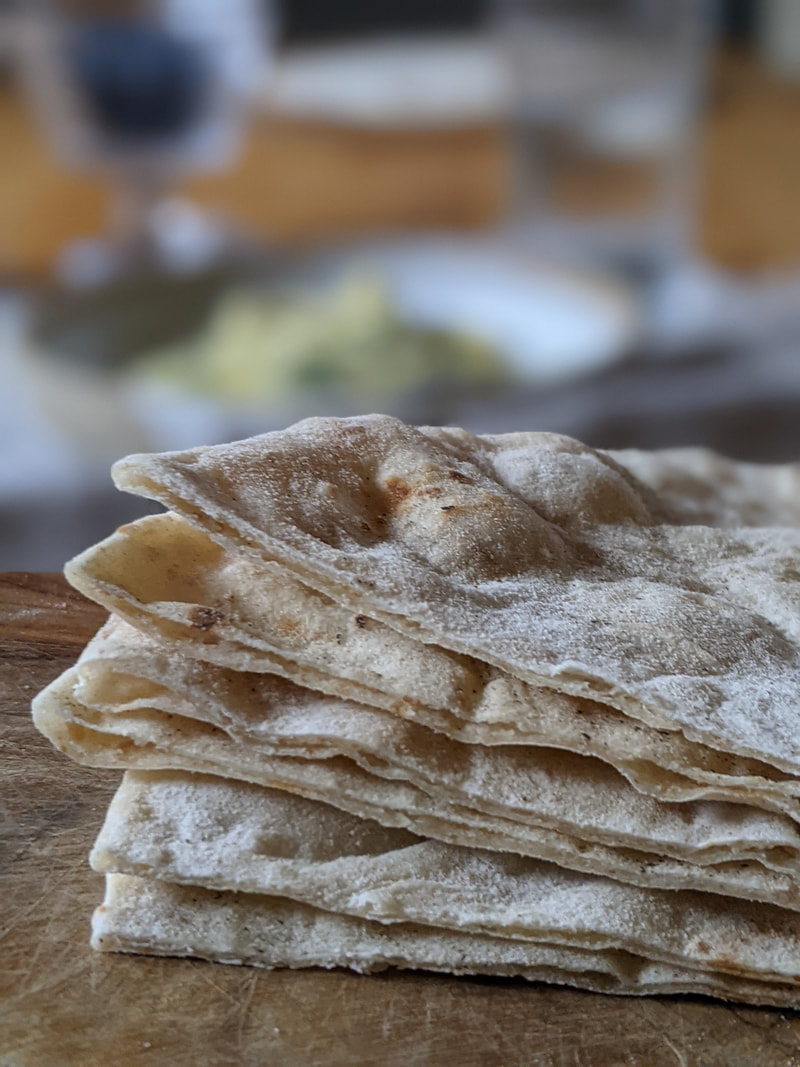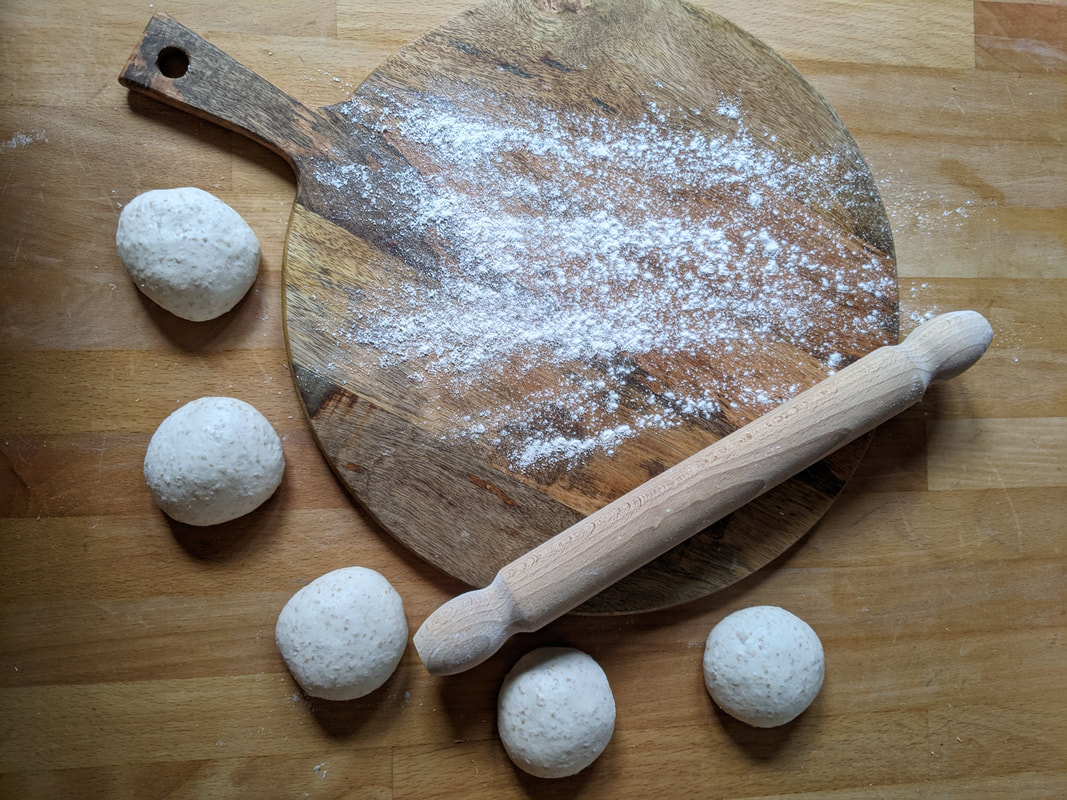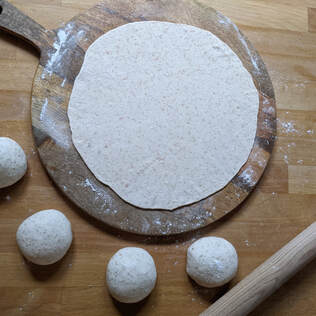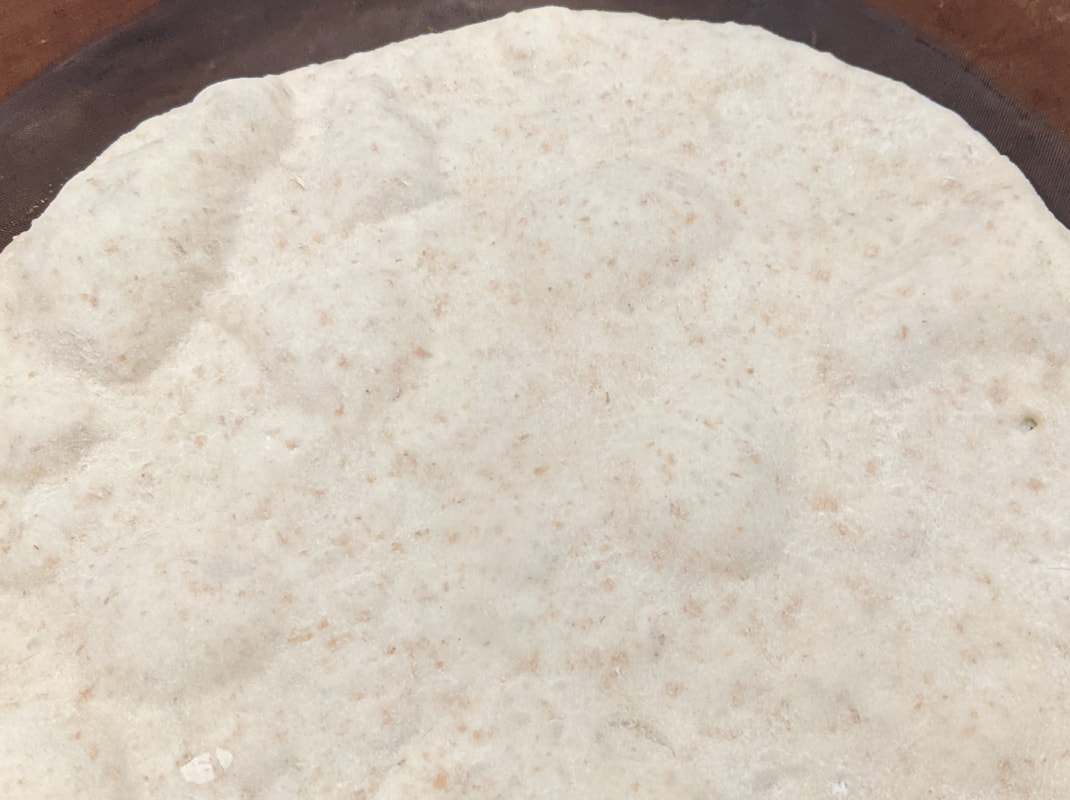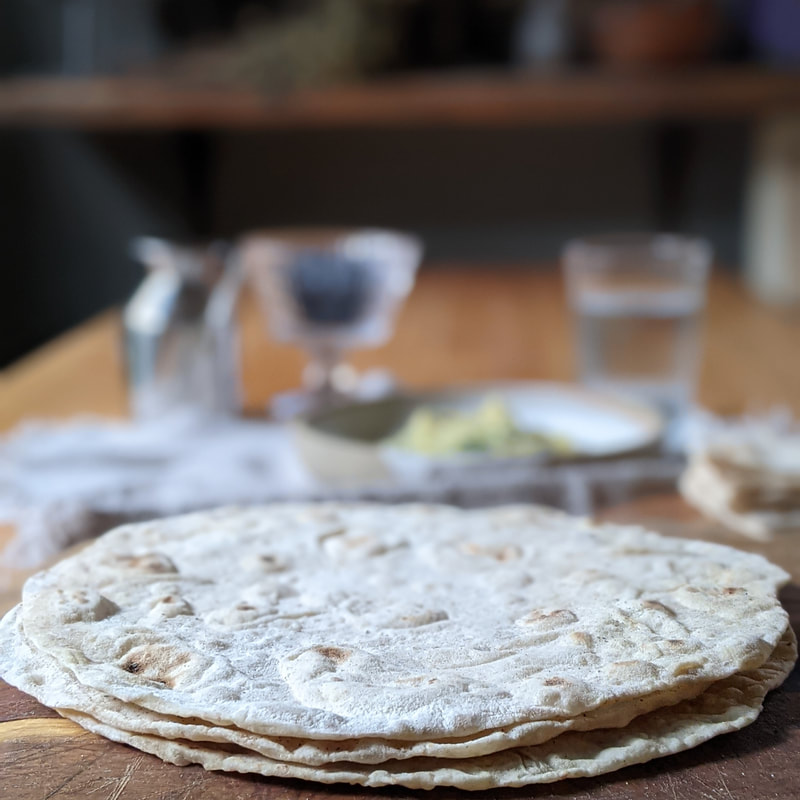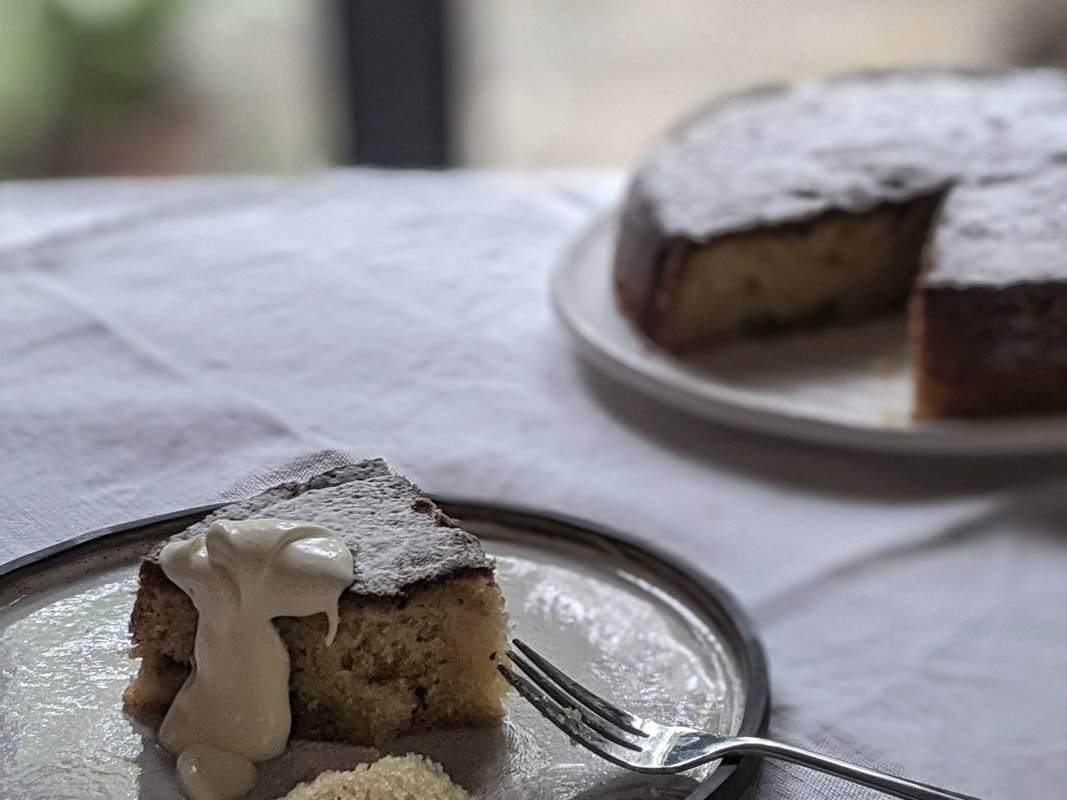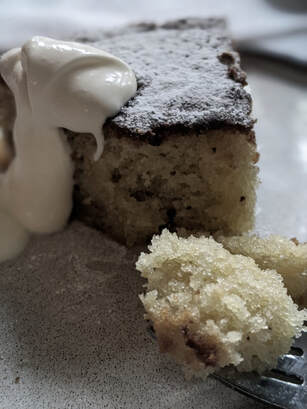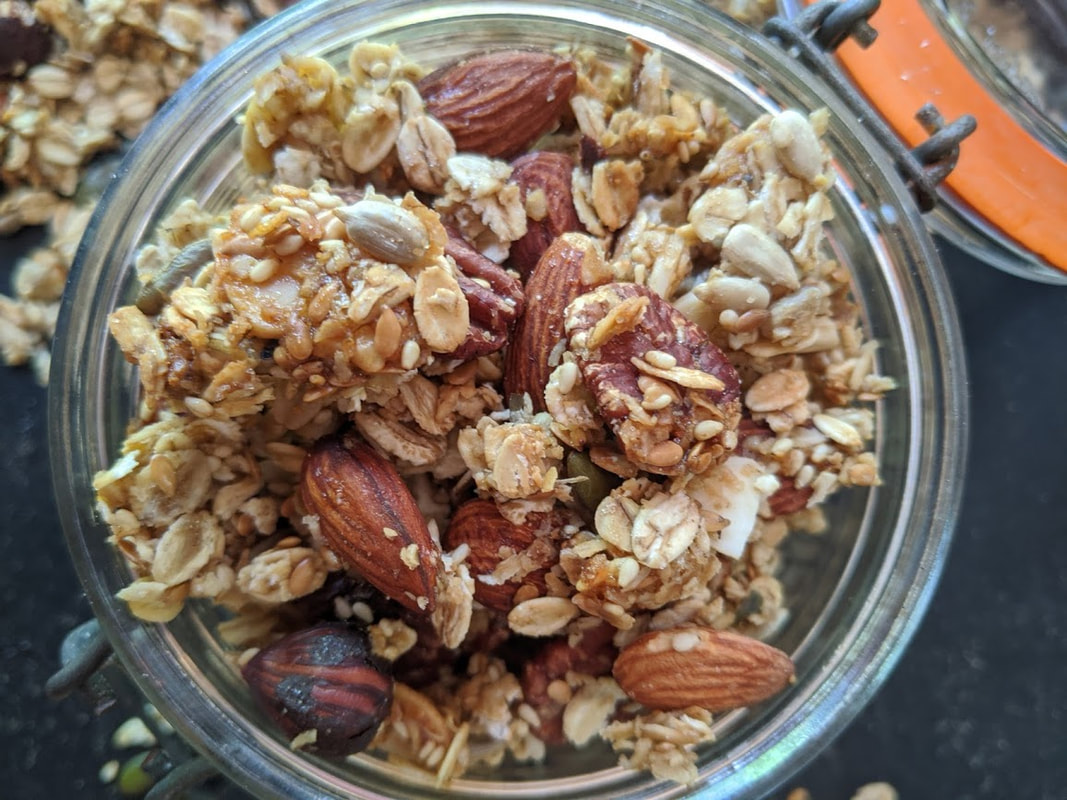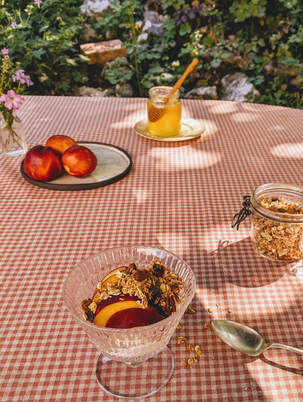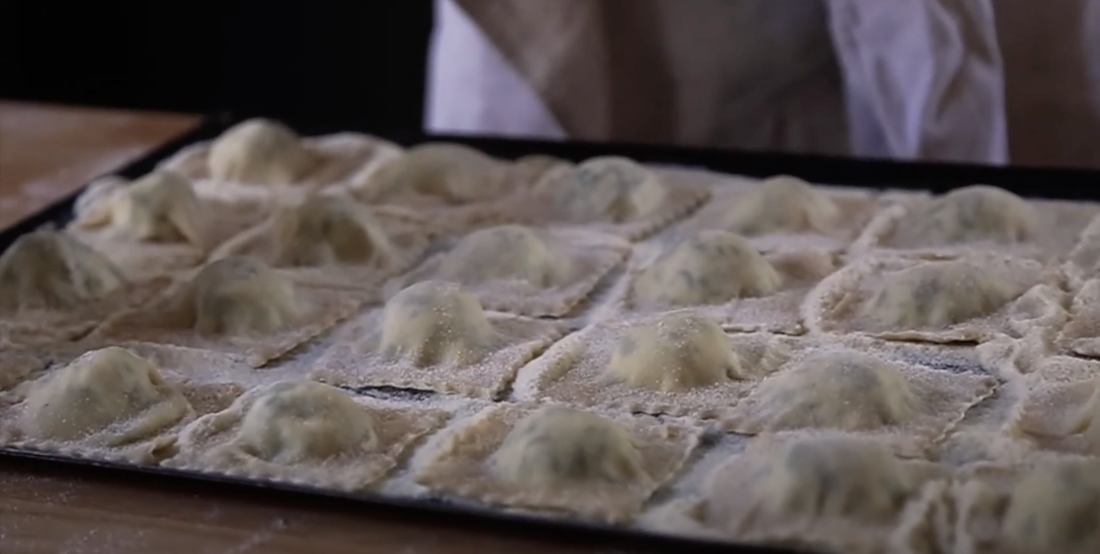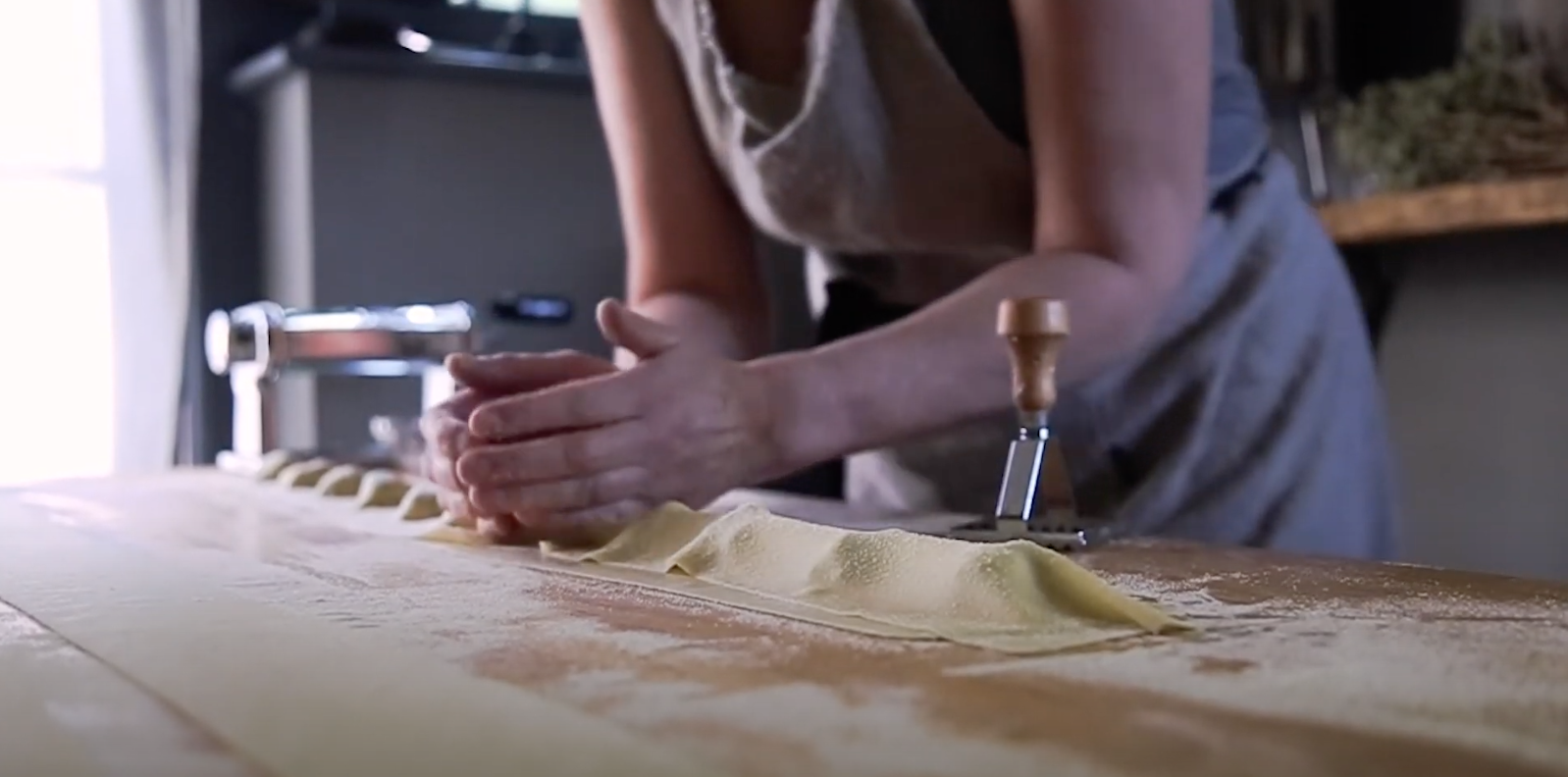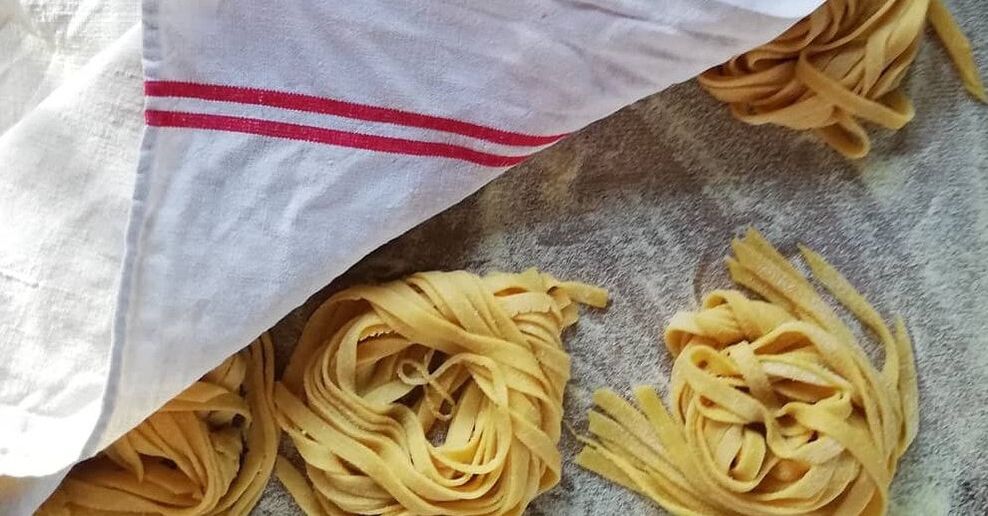Fluffy sourdough pancakes!
|
| Ingredients (Makes 2 hearts) For the dough: 450g strong white flour 50g wholemeal flour, eg spelt 2 large eggs 200g whole milk 2 tbsp runny honey 50g unsalted butter, melted 7g instant dried yeast 10g fine sea salt For the filling: 150g cream cheese 100g finely grated cheddar 50g yeast extract (eg Marmite) 1 egg, beaten to glaze. | |
Method
To make the enriched dough, place your flours in a bowl and add the yeast. In a jug, mix together the milk, honey, eggs, melted butter and salt. If using a mixer with a dough hook, place the liquid into your mixing bowl, then add your flour and yeast. If mixing by hand, you can pour the liquid ingredients into your bowl of flour and yeast. Mix together with a plastic scraper, until you have a formed a rough dough.
Turn out onto your counter and knead for approximately 15 minutes until you have a smooth and elastic dough. In a mixer, this will take half the time. Form into a ball, then place back in your bowl and cover. Leave at ambient temperature to prove for about 1.5 hours until the dough has roughly doubled in size. If your kitchen is cool, it may take a little longer.
Whilst it is proving, make the filling. Take 150g of cream cheese – any type, even mascarpone, whatever you have to hand – and add 100g of finely grated good cheddar – the sharp, flavourful mature kind. Now add about 50g Marmite (or any brand of yeast extract).
When ready, turn your dough out onto the counter and degas by slapping with the flat of your hand to remove any gas bubbles. Divide your dough into two equal halves, for the two hearts you will make. With a dusting of flour beneath, roll out each piece dough into a rectangle, approximately 25 x 40 cm. Using a knife or dough divider, cut into two rectangles 25cm x 20cm. Alternatively, if you have the space, you can roll out the entire piece of dough into one rectangle 50cm x 40cm and divide into 4 equal quarters. The resulting pieces of dough, 25cm x 20cm, will be the same.
Take your filling and spread half over each of the rectangles, being careful to leave about 1.5cm border all the way round. Now roll up each rectangle carefully, running a little water along the last edge, to seal the dough. You should end up with 4 long sausages of dough. Take each one, and making sure the dough has stretched evenly all the way to the end (pull the corner gently up if it has not). Pinch the ends together (wet a little inside if they are too floury to stick). Roll the ends in your two hands until you have created a sharp point at each end. Now gently roll each one to ensure the seam is secure, then taking each end gently stretch each roll until it is about 30cm long, taking care to stretch it evenly all along the roll. The gluten you have developed should make this stretch easily achievable.
To make the enriched dough, place your flours in a bowl and add the yeast. In a jug, mix together the milk, honey, eggs, melted butter and salt. If using a mixer with a dough hook, place the liquid into your mixing bowl, then add your flour and yeast. If mixing by hand, you can pour the liquid ingredients into your bowl of flour and yeast. Mix together with a plastic scraper, until you have a formed a rough dough.
Turn out onto your counter and knead for approximately 15 minutes until you have a smooth and elastic dough. In a mixer, this will take half the time. Form into a ball, then place back in your bowl and cover. Leave at ambient temperature to prove for about 1.5 hours until the dough has roughly doubled in size. If your kitchen is cool, it may take a little longer.
Whilst it is proving, make the filling. Take 150g of cream cheese – any type, even mascarpone, whatever you have to hand – and add 100g of finely grated good cheddar – the sharp, flavourful mature kind. Now add about 50g Marmite (or any brand of yeast extract).
When ready, turn your dough out onto the counter and degas by slapping with the flat of your hand to remove any gas bubbles. Divide your dough into two equal halves, for the two hearts you will make. With a dusting of flour beneath, roll out each piece dough into a rectangle, approximately 25 x 40 cm. Using a knife or dough divider, cut into two rectangles 25cm x 20cm. Alternatively, if you have the space, you can roll out the entire piece of dough into one rectangle 50cm x 40cm and divide into 4 equal quarters. The resulting pieces of dough, 25cm x 20cm, will be the same.
Take your filling and spread half over each of the rectangles, being careful to leave about 1.5cm border all the way round. Now roll up each rectangle carefully, running a little water along the last edge, to seal the dough. You should end up with 4 long sausages of dough. Take each one, and making sure the dough has stretched evenly all the way to the end (pull the corner gently up if it has not). Pinch the ends together (wet a little inside if they are too floury to stick). Roll the ends in your two hands until you have created a sharp point at each end. Now gently roll each one to ensure the seam is secure, then taking each end gently stretch each roll until it is about 30cm long, taking care to stretch it evenly all along the roll. The gluten you have developed should make this stretch easily achievable.
| Take one roll and shape like a cup handle, with the seam underneath. Take another and make the mirror image and place the two together on a baking tray, pinching together the two joins, both top and bottom. Now do the same for the remaining two rolls. Bear in mind, the dough hearts will double in size whilst they prove for a second time, so place on separate baking trays to give them plenty of space to grow. Cover the two hearts with cling film or a plastic bag whilst they prove. If you wish to bake the same day, leave at ambient temperature for 1.5-2 hours until they have appreciably grown in size and return slowly back to place when poked gently with your finger. If you wish to bake fresh in the morning, simply cover and leave in the fridge overnight for 8-12 hours and bake straight from the fridge (no need to bring back to room temperature). |
| Half an hour before you are ready to bake, preheat the oven to 220C. Then, just before you bake it is time to cut the each half of the heart, épi de blé style, with scissors. Holding the scissors very flat and snipping in line with the dough, following its curves, flip each cut alternately left then right. Finally, brush each with a little beaten egg, then place into the preheated oven. Immediately turn down the temperature of the oven and bake at 190C for about 20-25 minutes until golden brown and the centre of the dough has reached a temperature of 95C. Allow to cool on a rack. The hearts freeze well, due to fat content within the dough so you can always make ahead of time. You can re-bake straight from frozen in a hot oven for 10 mins or so, ready to tear and share whilst still warm or leave to cool once more on a rack. |
If you’re not a huge Marmite fan, you could add some chopped jalapenos with the cheddar and cream cheese instead. Or why not make a sweet cinnamon version, creaming together 150g softened butter, 100g soft brown sugar and a couple of teaspoons of ground cinnamon? Better still, make one of each!
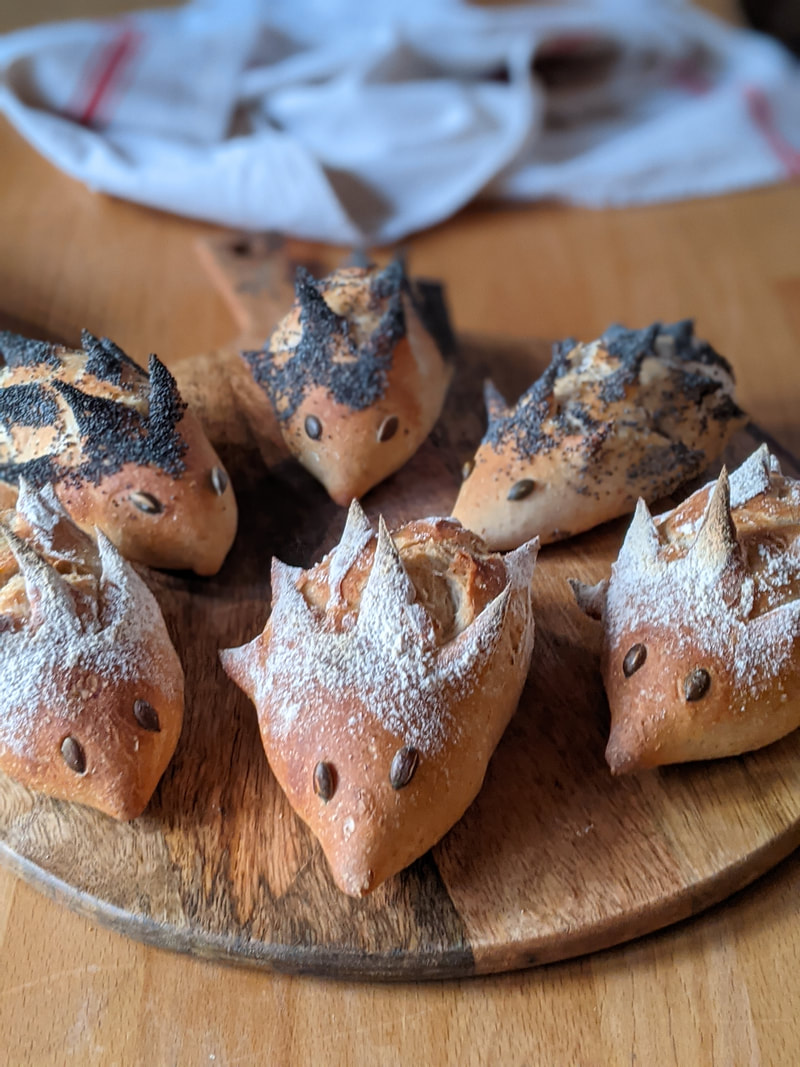
A little project for you or the kids. Or maybe you and your kids – make your own family of hedgehogs!
Kids can’t go wrong with dough. It’s doughty stuff! They can push it, pull it, tear it, thump it, drop it, throw it and it will thrive! Make this a fun activity at the weekend, or why not make it part of home-schooling when you need a break from relentless screen and book work, and tie it in with the science curriculum?
Did you know yeast is a fungus? It’s also known as sugar fungus (saccharomyces). All you need to make bread is flour, water, yeast and a little salt. Easy, huh? So easy, in fact, we’ve been doing it for thousands of years – on hot stones, in clay or iron pots, on ashes, in the ground under ashes... So, a modern oven and some ready dried yeast should make it a doddle!
To start producing the bubbles of gas to rise your bread, the yeast needs some sugar to feed on. It’s its best thing. And flour is full of it, but it’s all locked up in bigger starch molecules and the yeast can’t get to it. Once we add the water, the starch structures swell, allowing enzymes in the flour to work on the starch and break it into simple sugars. Yeast feasts on the sugar and produces carbon dioxide as a waste product. If bread was a liquid (like beer!) we’d see the bubbles rising to the surface, but in bread, it gets trapped by the stretchy gluten structure which fills like balloons within the dough.
Your job is to knead the bread to create the stretchy gluten ready to trap the gas and then wait until each ‘balloon’ has filled, so your bread is light and fluffy. Mostly, nature is going to do all the hard work for you.
All you need is some bread flour, a little salt, some ready dried yeast and some tap water. You don’t even need scales – you can cheat with a coffee mug and a teaspoon. Have fun!
Kids can’t go wrong with dough. It’s doughty stuff! They can push it, pull it, tear it, thump it, drop it, throw it and it will thrive! Make this a fun activity at the weekend, or why not make it part of home-schooling when you need a break from relentless screen and book work, and tie it in with the science curriculum?
Did you know yeast is a fungus? It’s also known as sugar fungus (saccharomyces). All you need to make bread is flour, water, yeast and a little salt. Easy, huh? So easy, in fact, we’ve been doing it for thousands of years – on hot stones, in clay or iron pots, on ashes, in the ground under ashes... So, a modern oven and some ready dried yeast should make it a doddle!
To start producing the bubbles of gas to rise your bread, the yeast needs some sugar to feed on. It’s its best thing. And flour is full of it, but it’s all locked up in bigger starch molecules and the yeast can’t get to it. Once we add the water, the starch structures swell, allowing enzymes in the flour to work on the starch and break it into simple sugars. Yeast feasts on the sugar and produces carbon dioxide as a waste product. If bread was a liquid (like beer!) we’d see the bubbles rising to the surface, but in bread, it gets trapped by the stretchy gluten structure which fills like balloons within the dough.
Your job is to knead the bread to create the stretchy gluten ready to trap the gas and then wait until each ‘balloon’ has filled, so your bread is light and fluffy. Mostly, nature is going to do all the hard work for you.
All you need is some bread flour, a little salt, some ready dried yeast and some tap water. You don’t even need scales – you can cheat with a coffee mug and a teaspoon. Have fun!
| Ingredients 750g strong white flour 450g tepid water (ie vaguely warm to the touch) 7g (one sachet) instant dried yeast 12g fine salt Or, if you don't have scales: 2 ½ x coffee mugs, loosely packed strong white flour 1 x coffee mug tepid water (full, to brim) 1 x 7g sachet fast action ready yeast 1 heaped teaspoon fine salt Method: Mix all your ingredients in a bowl until you have a rough dough and no loose flour left. Tip it out onto the counter and knead the dough for about 10 or 15 minutes until it’s smooth, elastic and stretchy. There are lots of ways to knead dough, but as long as you continuously push or pull the dough and then fold it back over itself, you’ll be developing that gluten. Once your dough is kneaded, form into a ball, put in a flour dusted bowl & cover with a cloth for about 1.5 hours until it’s doubled in size. Now remove the dough, slap it with the flat of your hand to remove all the gas before you divide it into 10—12 equal pieces of dough. | Shape each piece into a little round ball with a smooth top, taking care to squish out any bubbles that appear at this stage (plenty of time for more bubbles to grow as it proves for a second time). Now take a ball and fold over itself so you have an oval shape. Finally, roll one end to a long point for the ‘snout’ of your hedgehog. If you want to add seeds, now is the time. Dampen a cloth, roll your hedgehog’s back on the cloth, then roll it on a plate of poppy or black sesame seeds. Place each one on a baking tray, remembering to space well out as you want them to double in size. Cover again with a cloth and leave to prove for another 1.5 hours. Remember, yeast feeds more slowly if it's cold, so give it a little longer on a cold day or if your kitchen is cool. Never be tempted to hurry things along in an airing cupboard. They're usually much too warm! The yeast will be happy if you just let it take its time. |
Bread is baked in a really hot oven, so make sure you preheat your oven to 240C at least 20 minutes before you need to use it. Perhaps set a timer for 1 hour after you have shaped your hedgehogs to remind you to turn it on.
When your little rolls are ready, they will have roughly doubled in size and when you gently press the dough it will bounce slowly back. If you wish to, you can add a couple of pumpkin seeds or currants for eyes. For those you haven’t covered in seeds, you can sprinkle a little flour on their backs.
When your little rolls are ready, they will have roughly doubled in size and when you gently press the dough it will bounce slowly back. If you wish to, you can add a couple of pumpkin seeds or currants for eyes. For those you haven’t covered in seeds, you can sprinkle a little flour on their backs.
Before they go into the oven, we have to cut the hedgehogs’ ‘spikes’. To do this, hold your scissors almost horizontally and cut row upon row of spikes. You will cut them flat, but they will spike up as the dough springs up in the oven.
As the tray of rolls go into the oven, throw half an eggcup of water onto the bottom of the oven to provide some steam. Close the oven door and turn the temperature down to 220C and bake for 15-20 minutes until golden brown. The longer the bake the crisper the crust, so feel free to leave them in longer – just watch the tips of your hedgehogs’ spines don’t burn!
Allow to cool on a rack – a clean grill pan will do as long as air can circulate and allow the steam to escape from the roll or you’ll find the bottoms will be a bit soft and soggy.
Once cool, you can bag up (and freeze) any you don’t want straight away.
How will you eat yours? Tear off the spikes and dip into something delicious or cut open and fill with your favourite sandwich filling. How about hedgehog hotdogs? Have fun and happy baking!
Allow to cool on a rack – a clean grill pan will do as long as air can circulate and allow the steam to escape from the roll or you’ll find the bottoms will be a bit soft and soggy.
Once cool, you can bag up (and freeze) any you don’t want straight away.
How will you eat yours? Tear off the spikes and dip into something delicious or cut open and fill with your favourite sandwich filling. How about hedgehog hotdogs? Have fun and happy baking!
Apple cake with streusel topping
Delicious any time of year, this recipe was dreamt up in Winter in remembrance of snowy days during a relentless grey and dreary January. Each year, for many years, our little family has visited a favourite restaurant in a cosy wooden cabin, usually buried deep in snow and hidden half from view, on the French/Italian border. We usually steal a march on the lunchtime trade by dropping by late morning for a warming drink and a slice of the best apple cake I have ever tasted. We take our treasure and savour it en plein air, under the bluest of blue skies. In lieu of that for now, and hankering as I am for those bright, sunny, carefree days, I have baked my own version. It's close but I'm not sure anything will be quite up to the memory (it really is the BEST cake!). Perhaps I just need the snow under my feet, the warmth of the sun on my face and my lungs full of the that crisp, clean Alpine air...
Ingredients:
(Makes one round cake, 23cm-27cm diameter, or 20cm-23cm square tin )
For the caramelised apples:
3 dessert apples, sharp and crisp (eg English Cox), peeled, cored and cut into chunks
20g butter
20g brown sugar
For the streusel topping:
50g salted butter, room temperature
75g self-raising flour
50g demerara sugar
75g pecans, roughly chopped
For the cake batter:
250g self-raising flour
1 tsp baking powder
½ tsp fine sea salt
250g golden caster sugar
200g unsalted butter, softened
3 large eggs
1 tsp vanilla bean paste (or extract)
150g Greek yoghurt
Zest ½ lemon
Delicious any time of year, this recipe was dreamt up in Winter in remembrance of snowy days during a relentless grey and dreary January. Each year, for many years, our little family has visited a favourite restaurant in a cosy wooden cabin, usually buried deep in snow and hidden half from view, on the French/Italian border. We usually steal a march on the lunchtime trade by dropping by late morning for a warming drink and a slice of the best apple cake I have ever tasted. We take our treasure and savour it en plein air, under the bluest of blue skies. In lieu of that for now, and hankering as I am for those bright, sunny, carefree days, I have baked my own version. It's close but I'm not sure anything will be quite up to the memory (it really is the BEST cake!). Perhaps I just need the snow under my feet, the warmth of the sun on my face and my lungs full of the that crisp, clean Alpine air...
Ingredients:
(Makes one round cake, 23cm-27cm diameter, or 20cm-23cm square tin )
For the caramelised apples:
3 dessert apples, sharp and crisp (eg English Cox), peeled, cored and cut into chunks
20g butter
20g brown sugar
For the streusel topping:
50g salted butter, room temperature
75g self-raising flour
50g demerara sugar
75g pecans, roughly chopped
For the cake batter:
250g self-raising flour
1 tsp baking powder
½ tsp fine sea salt
250g golden caster sugar
200g unsalted butter, softened
3 large eggs
1 tsp vanilla bean paste (or extract)
150g Greek yoghurt
Zest ½ lemon
| Prepare your chosen round or square cake tin by lining and greasing well. A smaller tin will produce a taller cake, but keep within the size guidelines. Preheat your oven to 350F/180C (160C fan). First prepare your apples, by melting the 20g butter and sugar together in heavy bottomed pan and allow to caramelise. Add your chopped apples, coat in the caramel and cook on a medium heat for 5-6 minutes, turning occasionally. Transfer to a plate and leave to cool. Now prepare your crumble topping: rub the room temperature butter into the flour lightly with your fingertips. You don’t need to ensure even ‘breadcrumb’ texture as you want a varied crumbly texture. Add the demerara sugar and mix evenly. Set to one side with the chopped pecans. To make the cake batter, sift together the salt, baking powder and flour. In another bowl, cream your sugar and butter together until pale and fluffy – 4-5 minutes. |
| Sprinkle the chopped pecans over the top and, lastly, the streusel topping. Place on the middle shelf of the oven and bake for 50-60 minutes. The cake will be cooked when the top is firm and a skewer comes out clean. Or, better still, use a probe thermometer. The cake will be cooked when the thermometer reads around 96C-98C. If you bake a cake to temperatures beyond this the moisture will be start to be lost and your cake will begin to dry out. When cooked, remove the cake from the oven but leave in the tin for 10 minutes or so, before placing on a wire rack to cool. Delicious warm or cold, and wonderful with a dollop of sour cream or Greek yoghurt. Pour yourself a cup of tea, find a good book and just take five! | Now whisk your eggs together and gradually incorporate into your creamed butter mix. If you mix in 5 or 6 additions they egg shouldn’t curdle, but don’t panic if you add a little too quickly and the mix does separate a little. All will be well! Whisk in your Greek yoghurt, lemon zest and vanilla until smoothly incorporated. Now switch to a metal spoon and gently fold in your remaining dry ingredients about a quarter at a time, working as little as possible to establish a homogenous mix. If the mix seems a little too stiff, you can let down the mixture by adding a tablespoon or two of milk. This may happen if your Greek yoghurt is particularly thick – the texture varies greatly from brand to brand, or even batch to batch! Finally, gently fold in your cooled caramelised apples and pour/spoon the batter into your prepared tin. |
Flour tortillas
A quick, easy and versatile flat bread, the tortilla can be used for wraps, dips, quesadillas etc. They can be rustled up for an emergency lunch or supper without planning ahead of time which make them super useful when you feel like you're feeding the five thousand and really can't face another trip to the shops! No need for fancy equipment like a tortilla press - these will be easily rolled with a rolling pin as the wheat flour produces an elastic dough. Tortilla presses are used for traditional corn tortillas which are naturally gluten free and have no such elasticity.
Feel free to use all plain flour if you have no wholemeal in the cupboard.
Finally, for best results use lard (or vegetable shortening) but you can use butter if you don't have any to hand.
We like to use up old sourdough starter in our bakery recipe, but if you don't keep a starter, replace the starter with 75g of extra water plus 75g of extra white flour. This is an almost instant recipe — ready and baked in little more than half an hour, but you can keep the dough wrapped in the fridge for 2-3 days. It is not strictly unleavened, as we use a little baking powder which supplies a little lift on the griddle, giving a lighter, almost flakier, layered tortilla.
Ingredients:
(Makes 6 tortillas)
200g plain flour
1 tsp baking powder
1/2 tsp fine sea salt
15g lard (or vegetable shortening)
160g water
150g liquid starter (unrefreshed, but not too acidic. Ideally, 2-3 days old)*
*or substitute 75g flour + 75g water
A quick, easy and versatile flat bread, the tortilla can be used for wraps, dips, quesadillas etc. They can be rustled up for an emergency lunch or supper without planning ahead of time which make them super useful when you feel like you're feeding the five thousand and really can't face another trip to the shops! No need for fancy equipment like a tortilla press - these will be easily rolled with a rolling pin as the wheat flour produces an elastic dough. Tortilla presses are used for traditional corn tortillas which are naturally gluten free and have no such elasticity.
Feel free to use all plain flour if you have no wholemeal in the cupboard.
Finally, for best results use lard (or vegetable shortening) but you can use butter if you don't have any to hand.
We like to use up old sourdough starter in our bakery recipe, but if you don't keep a starter, replace the starter with 75g of extra water plus 75g of extra white flour. This is an almost instant recipe — ready and baked in little more than half an hour, but you can keep the dough wrapped in the fridge for 2-3 days. It is not strictly unleavened, as we use a little baking powder which supplies a little lift on the griddle, giving a lighter, almost flakier, layered tortilla.
Ingredients:
(Makes 6 tortillas)
200g plain flour
1 tsp baking powder
1/2 tsp fine sea salt
15g lard (or vegetable shortening)
160g water
150g liquid starter (unrefreshed, but not too acidic. Ideally, 2-3 days old)*
*or substitute 75g flour + 75g water
| Method: Sift together the salt, baking powder and flour, then rub in the lard or vegetable shortening until you have breadcrumb-like texture. Add the water and mix into a dough using a dough scraper. Turn out onto your counter and knead for a few minutes until you have a smooth and elastic dough. (Alternatively throw into a mixer with a dough hook for a few minutes). Wrap and leave to rest for 20-30 minutes for the gluten to relax before dividing your dough into six equal pieces (approx. 85g), roll into little balls and cover with a cloth whilst you roll individual ones out. |
| The tortilla is ready to turn when you see it blistering all over (about 30-45 seconds), flip and bake on the other side for another 30 seconds or so. If you over-bake, the dough will begin to crisp. Practise will make perfect! You can stack the tortillas as you bake each one, but cover with a cloth each time, to ensure they keep the steam in and remain soft and pliable as they cool. The cooked tortillas can be wrapped when cool and kept for several days, or you can divide the dough, keep some in the fridge for 2-3 days and cook fresh when needed. | Flour your counter well then, using a floured rolling pin, roll each piece into a thin disc, approximately 25cm in diameter and ensure they are well-floured as you stack them ready for baking. Ideally, make two piles of three, to prevent them sticking together. This dough is very soft so should easily roll, but you may need to be diligent with keeping both your counter and the rolling pin floured. Turning your tortilla over regularly will help keep it from sticking. Once you’ve practised a couple of times, it should only tale a minute or so to roll out each one. Before baking, prepare your griddle or heavy skillet by ensuring it is very hot before you start cooking. Have a plate or steam basket ready to stack them as each comes out of the pan and a clean tea towel ready to cover them and keep them soft. Each tortilla should only take about a minute or so in the pan — no need for oil. |
This is fast becoming one of my favourite go-to cake recipes. I love the flavour and tender crumb that comes from the addition of sour cream in a cake batter. We can also use a little less butter as a consequence. You can play around with the quantity of ground almonds you use, so don’t panic if you don’t quite have enough – just substitute the missing almonds with more flour. Ground almonds always produce a deliciously moist cake with great keeping qualities.
Here, I wanted to use the very last of my greengages, but any firm fruit would do. Try to avoid very soft and ripe fruit or you will find the base of your cake may become a little soggy. If that should happen, you’ll have a very happy accident: just serve warm with some vanilla ice cream or crème fraiche and it becomes a delicious pudding!
Here, I wanted to use the very last of my greengages, but any firm fruit would do. Try to avoid very soft and ripe fruit or you will find the base of your cake may become a little soggy. If that should happen, you’ll have a very happy accident: just serve warm with some vanilla ice cream or crème fraiche and it becomes a delicious pudding!
Ingredients
Ground almonds 100g
Plain flour 75g
Baking powder 1 tsp
Bicarb of soda ¼ tsp
Vanilla essence 1 tsp
Sour cream 60ml (= 4 tbsp)
Caster sugar 150g
Butter, softened 125g
3 eggs
Approx 10-12 firm greengages or plums
Icing sugar for dusting
You will need one 9” (23cm) spring-form cake tin, greased and lined.
Preheat your oven to 180°C/160°C fan/350°F
Method
For ease and convenience, you can make this cake batter in your mixer, using the all-in-one method, but I prefer to make the extra effort to separate my eggs and fold in my egg whites.
First sieve together your flour, baking powder and bicarb of soda then add your ground almonds and set aside. Next beat together your sugar and softened butter until light and creamy. Add your vanilla essence and sour cream and beat for a few more seconds.
Now separate your eggs. Place the yolks in your creamed butter and combine. With a clean whisk, beat the egg whites until you have stiff peaks (ensure both whisk and bowl are completely fat/oil/yolk free).
Finally, you can combine the dry ingredients, the egg whites and butter cream. Do this in thirds, folding first a third of the egg whites into the butter cream mixture, then a third of the almonds/flour. Keep alternating and gently folding, trying to retain much of the light airiness provided by the egg whites as you go, until you have incorporated all the ingredients and have a well-combined, light cake batter.
Pour/spoon cake mixture into your lined and greased cake tin. On top, arrange your halved, de-stoned fruit (either way up – the fruit will sink lower), and place in the oven and bake for 50-60mins.
Ground almonds 100g
Plain flour 75g
Baking powder 1 tsp
Bicarb of soda ¼ tsp
Vanilla essence 1 tsp
Sour cream 60ml (= 4 tbsp)
Caster sugar 150g
Butter, softened 125g
3 eggs
Approx 10-12 firm greengages or plums
Icing sugar for dusting
You will need one 9” (23cm) spring-form cake tin, greased and lined.
Preheat your oven to 180°C/160°C fan/350°F
Method
For ease and convenience, you can make this cake batter in your mixer, using the all-in-one method, but I prefer to make the extra effort to separate my eggs and fold in my egg whites.
First sieve together your flour, baking powder and bicarb of soda then add your ground almonds and set aside. Next beat together your sugar and softened butter until light and creamy. Add your vanilla essence and sour cream and beat for a few more seconds.
Now separate your eggs. Place the yolks in your creamed butter and combine. With a clean whisk, beat the egg whites until you have stiff peaks (ensure both whisk and bowl are completely fat/oil/yolk free).
Finally, you can combine the dry ingredients, the egg whites and butter cream. Do this in thirds, folding first a third of the egg whites into the butter cream mixture, then a third of the almonds/flour. Keep alternating and gently folding, trying to retain much of the light airiness provided by the egg whites as you go, until you have incorporated all the ingredients and have a well-combined, light cake batter.
Pour/spoon cake mixture into your lined and greased cake tin. On top, arrange your halved, de-stoned fruit (either way up – the fruit will sink lower), and place in the oven and bake for 50-60mins.
| Your cake will be cooked when a skewer comes out clean and the cake has shrunk from the sides. Ideally, use a probe thermometer. The cake will be perfectly cooked between 96°C and 99°C. Below, 96°C, the cake will not be quite cooked on the bottom, where it is moistest, and above 100°C, the moisture in the cake will begin to evaporate and your cake will be drier than need be. Release from the tin and allow to cool on a rack. When cool, dust with icing sugar. You can serve warm as a pudding, or cold as tea or coffee cake. Or, equally, you can serve as ‘that was a great workout’ cake or ‘I miss my friends’ cake or ‘great to see you, here’s to friendship’ cake or ‘I wanted to impress my friends, but I’ve just impressed myself’ cake or simply ‘this is just for me, I need impress no one’ cake. Personally, I need no excuse for cake. Store in a cake tin only when completely cooled. Keep in a cool, dry place. |
White Cottage Granola
(makes 1 large jar)
I’m a huge fan of granola but I'm really quite fussy. I like it to be nutty, have no fruit (I’ll add that fresh) and be not too sweet. It’s hard to find one that’s just right. The great thing about making your own is that you can hone the recipe to suit your own tastes - a little more honey or maple syrup if you have a sweet tooth and you can add your own particular favourite mix of seeds and nuts. Similarly, if you’re a fan of dried fruit, you can add 100g dried fruit such as raisins, apricots, dates or sultanas. And it just couldn't be simpler. You'll wonder why you haven't made it before.
Ingredients
Mixed rolled grains, eg oats, wheat, barley, spelt or rye* 250g
Mixed seeds, eg pumpkin, sunflower, sesame, flax 125g
Mixed nuts, eg pecan, brazil, hazelnuts, whole or flaked almonds 125g
Light brown sugar 30g
Runny honey 50g
Light vegetable oil, 30g
*If you only have oats, it’s fine to use just oats but try to use a jumbo or large flake version.
| Method Preheat your oven to 140C. Place the oil, honey and sugar in a large bowl and combine. To this, now add the mixed nuts and seeds and coat well. Now add your rolled grain flakes and combine evenly. The simplest way to do this is to get your hands in and rub the sticky seed/nut mixture through thoroughly. Spread out onto a large baking tray covered in a silicon or greaseproof paper sheet, making sure it and spread as thin as possible and evenly to the edges. Bake for about 30 minutes, turning your tray halfway through the baking time, if necessary. Allow to cool on the tray, then break it up a little with your hands. When completely cool, lift up the sheet and slide the granola off into a clean storage jar. It will keep for several weeks in an airtight container. It makes a great gift too - bagged up, tied up with string and labelled with your own personal label. |
Another in our series of recipes using up old sourdough starter or 'discard'.
This sticky, traditional spiced ginger cake is a delicious teatime treat, redolent of high teas and simpler days gone by. I’ve been asked for the recipe so many times, I thought I’d share it with you. I’ve updated it with a tangy lemon and soured cream frosting to cut through the treacly stickiness of the cake. It’s also a perfect vehicle for using up old starter – plenty of depth of flavour in this cake that is only enhanced by the mild acidity of your old starter – anything from 2-5 days old is perfect. But, if you don’t have any sourdough starter on the go, you can substitute with an additional 75g plain flour and 75g of milk with a teaspoon of lemon juice.*
Traditional gingerbread with lemon sour cream frosting
(makes 1 large loaf cake in an 800g/2 lb tin, or one tray bake.
Halve recipe for 1 small loaf cake)
For the cake:
Plain flour 225g
Butter, melted 150g
Golden syrup 200g
Treacle or blackstrap molasses 200g
Old liquid starter* 150g
Dark brown sugar 100g
Milk 175g
Medium eggs 2, lightly beaten
Bicarb of soda 1 tsp
Fine sea salt ½ tsp
Cinnamon 1 tsp
Ginger 4 tsp
Ground cloves ½ tsp
5-6 pieces preserved ginger, chopped (optional)
For the lemon sour cream frosting:
Unsalted butter, softened 150g
Icing sugar, sifted 300g
Thick sour cream or crème fraiche 100g
Zest of 1 lemon
Method
Preheat your oven to 160°C (140°C Fan)/320°F
Firstly, mix together your melted butter, syrup and treacle. Add your brown sugar, milk and old starter to the syrup mixture and combine thoroughly. If the starter is a few days old, the gluten will mostly be broken down and it will bring a delicious tang to this richly flavoured cake. Now you can mix in the lightly beaten egg to the rest of the wet ingredients.
In another bowl, sift together your flour, bicarb, spices and salt. If using chopped preserved ginger, you can add this to the dry, sifted mix and coat the little pieces well with the flour. Now pour the wet mixture into your bowl of dry ingredients, gently stirring until combined, and no pockets of flour remain. Pour the batter into your greased and lined loaf tin or tray.
Place your tin into the preheated oven. The wet batter mix is going to need long, slow baking - approximately 60 mins. Check the cake after 50-55 minutes. The cake will appear ‘set’ if gently jiggled, will have shrunk away from the sides and a skewer will come out clean. However, it is far easier to use a digital probe thermometer, which takes the guess work out of baking and avoids the disappointment of a soggy middle or bottom. The cake will be ideally cooked in the range of 96°C-99°C. At 100°C, the moisture in the cake will begin to evaporate, leaving your cake a little dry.
When cooked, leave to cool for twenty minutes or so in the tin and then turn out to cool completely on a wire rack before icing.
To prepare the icing:
Make sure your butter is very soft before attempting to mix your icing. Use the butter softening mode on your microwave, if necessary. Then, to the softened butter add your sifted icing sugar and gently blend in with a wooden spoon or hand mixer. Once incorporated, you can beat your buttercream until light and airy, then beat in your thick sour cream or crème fraiche and the finely grated lemon zest.
When the cake is completely cool, frost and decorate your cake with fine strips of lemon zest.
Store somewhere cool - remember the frosting contains fresh dairy.
This sticky, traditional spiced ginger cake is a delicious teatime treat, redolent of high teas and simpler days gone by. I’ve been asked for the recipe so many times, I thought I’d share it with you. I’ve updated it with a tangy lemon and soured cream frosting to cut through the treacly stickiness of the cake. It’s also a perfect vehicle for using up old starter – plenty of depth of flavour in this cake that is only enhanced by the mild acidity of your old starter – anything from 2-5 days old is perfect. But, if you don’t have any sourdough starter on the go, you can substitute with an additional 75g plain flour and 75g of milk with a teaspoon of lemon juice.*
Traditional gingerbread with lemon sour cream frosting
(makes 1 large loaf cake in an 800g/2 lb tin, or one tray bake.
Halve recipe for 1 small loaf cake)
For the cake:
Plain flour 225g
Butter, melted 150g
Golden syrup 200g
Treacle or blackstrap molasses 200g
Old liquid starter* 150g
Dark brown sugar 100g
Milk 175g
Medium eggs 2, lightly beaten
Bicarb of soda 1 tsp
Fine sea salt ½ tsp
Cinnamon 1 tsp
Ginger 4 tsp
Ground cloves ½ tsp
5-6 pieces preserved ginger, chopped (optional)
For the lemon sour cream frosting:
Unsalted butter, softened 150g
Icing sugar, sifted 300g
Thick sour cream or crème fraiche 100g
Zest of 1 lemon
Method
Preheat your oven to 160°C (140°C Fan)/320°F
Firstly, mix together your melted butter, syrup and treacle. Add your brown sugar, milk and old starter to the syrup mixture and combine thoroughly. If the starter is a few days old, the gluten will mostly be broken down and it will bring a delicious tang to this richly flavoured cake. Now you can mix in the lightly beaten egg to the rest of the wet ingredients.
In another bowl, sift together your flour, bicarb, spices and salt. If using chopped preserved ginger, you can add this to the dry, sifted mix and coat the little pieces well with the flour. Now pour the wet mixture into your bowl of dry ingredients, gently stirring until combined, and no pockets of flour remain. Pour the batter into your greased and lined loaf tin or tray.
Place your tin into the preheated oven. The wet batter mix is going to need long, slow baking - approximately 60 mins. Check the cake after 50-55 minutes. The cake will appear ‘set’ if gently jiggled, will have shrunk away from the sides and a skewer will come out clean. However, it is far easier to use a digital probe thermometer, which takes the guess work out of baking and avoids the disappointment of a soggy middle or bottom. The cake will be ideally cooked in the range of 96°C-99°C. At 100°C, the moisture in the cake will begin to evaporate, leaving your cake a little dry.
When cooked, leave to cool for twenty minutes or so in the tin and then turn out to cool completely on a wire rack before icing.
To prepare the icing:
Make sure your butter is very soft before attempting to mix your icing. Use the butter softening mode on your microwave, if necessary. Then, to the softened butter add your sifted icing sugar and gently blend in with a wooden spoon or hand mixer. Once incorporated, you can beat your buttercream until light and airy, then beat in your thick sour cream or crème fraiche and the finely grated lemon zest.
When the cake is completely cool, frost and decorate your cake with fine strips of lemon zest.
Store somewhere cool - remember the frosting contains fresh dairy.
During the Spring and early Summer, there are so many wild herbs to be foraged from the hedgerows or our own gardens. I've made this pasta time and time again, varying the mix of greens I've used each time. I often add sorrel from the garden for its citrusy bite, but I will literally use anything green and leafy, including foraged nettle tips, wild garlic or fat hen. Later in the year, you can raid your vegetable patch for the tenderest tips of spinach, kale or rocket, and throw in some favourite leafy herbs.
Click here to watch the video tutorial, or read below!
Click here to watch the video tutorial, or read below!
(Makes 25-30 medium ravioli)
1 batch sourdough pasta dough
(see our sourdough pasta recipe here)
For the filling:
Fresh ricotta 500g
Fresh greens/herbs 100g (approx.)
Pecorino, grated 20g
½ nutmeg, grated
Sea salt and freshly ground black pepper
For the sage butter:
About 24 sage leaves
Butter (1/2 pack) 125g
Prepare your filling whilst your dough is resting:
Take 500g of ricotta and place in a heavy bottomed, wide pan over a medium heat for about 10 minutes, stirring occasionally. About ¼ of the overall weight will evaporate during this process, leaving it resembling a soft cottage cheese. Remove from heat, stir in the grated pecorino (or other hard Italian cheese) and season with a good pinch of sea salt, some freshly ground black pepper and about half a freshly grated nutmeg. Taste a little to check seasoning before adding your chopped greens and herbs. Any soft leaved greens/herbs may be used: spinach, wild garlic, sorrel, young nettle tips etc. Whatever you can forage safely from the hedgerows or your own gardens (or fridges!).
1 batch sourdough pasta dough
(see our sourdough pasta recipe here)
For the filling:
Fresh ricotta 500g
Fresh greens/herbs 100g (approx.)
Pecorino, grated 20g
½ nutmeg, grated
Sea salt and freshly ground black pepper
For the sage butter:
About 24 sage leaves
Butter (1/2 pack) 125g
Prepare your filling whilst your dough is resting:
Take 500g of ricotta and place in a heavy bottomed, wide pan over a medium heat for about 10 minutes, stirring occasionally. About ¼ of the overall weight will evaporate during this process, leaving it resembling a soft cottage cheese. Remove from heat, stir in the grated pecorino (or other hard Italian cheese) and season with a good pinch of sea salt, some freshly ground black pepper and about half a freshly grated nutmeg. Taste a little to check seasoning before adding your chopped greens and herbs. Any soft leaved greens/herbs may be used: spinach, wild garlic, sorrel, young nettle tips etc. Whatever you can forage safely from the hedgerows or your own gardens (or fridges!).
Roll out your sourdough pasta, either by hand or machine until it is nice and thin. If using a machine, roll a quarter piece at a time and keep passing through until you are on the thinnest or near thinnest setting. If rolling by hand, roll it as thin as you can reasonably can, trying to keep the thickness even and then divide into 4 long equal-sized strips.
Now place a small spoonful (the size of a small walnut) of your filling in a row along your 2 of your pasta sheets, allowing room for each raviolo to be cut out. Using your finger, or a small brush, dampen the area in a square around each mound of filling. This will make the ‘lid’ stick as you carefully place the other 2 sheets over the top of the 2 filled sheets.
Now place a small spoonful (the size of a small walnut) of your filling in a row along your 2 of your pasta sheets, allowing room for each raviolo to be cut out. Using your finger, or a small brush, dampen the area in a square around each mound of filling. This will make the ‘lid’ stick as you carefully place the other 2 sheets over the top of the 2 filled sheets.
Now, carefully cup your hands around each ravioli mound, sealing each individual one, trying to avoid trapping any air inside. When you have finished, it is time to cut the ravioli out. You can use a square ravioli cutter, a pastry/pasta roller, or simply a knife. If using the latter, make sure you crimp and seal the edges of each one with a fork.
If you are not cooking your ravioli straight away, coat in a little semolina or rice flour (not ordinary flour) to prevent sticking together. Place on a tray and cover until needed (in the fridge, if necessary).
If you are not cooking your ravioli straight away, coat in a little semolina or rice flour (not ordinary flour) to prevent sticking together. Place on a tray and cover until needed (in the fridge, if necessary).
Just before you are ready to eat, prepare the sage butter: Put half a pack of butter in a heavy bottomed pan and place over a medium heat. Let the butter melt, then throw in a dozen or so whole sage leaves. Allow them to crisp but not burn in the butter. Remove and place on a paper towel as they crisp, then turn up the heat a little and watch as your butter first bubbles, then finally foams and becomes glorious-smelling browned butter. Throw in the rest of chopped sage at the last and take off the heat and allow the chopped sage to steep in the hot butter as you bring your largest pot of water to the boil.
Now it’s time to cook the pasta. Add salt to the pan, bring to a rolling boil, then place the ravioli in the pan and cook for approx. 3 mins until tender and ‘al dente’. Depending upon the size of your pan, you may need to cook in 2 or 3 batches, but this shouldn’t matter as they are so quick to cook.
Drain the cooked pasta well, pour over the sage brown butter and garnish with some of the whole, crispy sage leaves. Serve with a simple dressed green salad of garden leaves and enjoy!
Now it’s time to cook the pasta. Add salt to the pan, bring to a rolling boil, then place the ravioli in the pan and cook for approx. 3 mins until tender and ‘al dente’. Depending upon the size of your pan, you may need to cook in 2 or 3 batches, but this shouldn’t matter as they are so quick to cook.
Drain the cooked pasta well, pour over the sage brown butter and garnish with some of the whole, crispy sage leaves. Serve with a simple dressed green salad of garden leaves and enjoy!

Pasta is a simple flour and liquid (either egg or water) mixture that is kneaded into a stiff dough – an ideal way to use up starter that is a few days old, rather than discarding before you next refresh. This recipe uses liquid starter. If you are keeping a stiff starter, simply adjust the quantities to accommodate (about 15g less flour and add 15g water). If you are making vegan pasta, replace the egg with 100-110g of water.
You can make pasta with fine semolina (from the Southern Italian hard or ‘durum’ wheat) or with fine pasta grade ‘00’ flour. I often make mine with a mix of the two.
Watch our video tutorial on Youtube here or read below.
You can make pasta with fine semolina (from the Southern Italian hard or ‘durum’ wheat) or with fine pasta grade ‘00’ flour. I often make mine with a mix of the two.
Watch our video tutorial on Youtube here or read below.
Basic sourdough pasta dough
(Makes about 450g)
Ingredients:
‘00’ flour 100g
Semolina 150g
Liquid starter 100g
Medium eggs 2
Dash of olive oil
Method:
Mix the semolina and ‘00’ flour in a large bowl. Traditionally, a ‘well’ is made in the middle of the flour into which you can add your liquid starter and eggs. Using a regular knife, dough scraper or simply two fingers, start to mix the dough from the centre, incorporating more of the flour as you stir until you have a stiff dough and all the flour has been absorbed. Add a dash of olive oil and knead in before turning your dough out onto a clean surface. Knead for five or so minutes until you have a smooth and elastic dough. Wrap in cling film and rest for 30 minutes or so.
Once rested, dust your counter with semolina before rolling your dough. You can pass through your pasta machine or roll out using a rolling pin. If using a pasta machine, divide into 4 pieces, keeping those you are not yet using wrapped. Pass the first piece through the machine on its thickest setting. Fold the resulting long strip of dough into thirds over itself, turn through 90 degrees and pass through the machine again. You should have a smooth homogeneous strip that you can pass through the machine at successive thicknesses until the desired thickness is reached (usually the thinnest or one above the thinnest setting). Repeat for the 3 other pieces of dough.
You will end up with 4 long strips of dough that can be passed through the shaper on your machine to make fettucine, tagliatelle etc. Or you can hand cut as desired. Place the cut and shaped pasta in a bed of semolina or rice flour and give it a fine coating to prevent sticking – if you use regular flour, it will be absorbed and your pasta will stick to itself. If rolling by hand, try and keep an even thickness throughout – you may find it easier to divide your dough into smaller pieces before rolling, until you are more practiced at this.
Depending upon the final pasta shape you have chosen, you can hang your pasta or leave on semolina-coated trays, covered with a cloth, ready for when you want to cook. When ready to cook, bring water to boil in your largest pan (which allow the pasta plenty of space to remain separate and the temperature of such a big pot won’t drop so significantly when you add the pasta), throw in some salt and cook for 3-4 minutes only. A simple sauce with oil or butter, will allow you to appreciate the delicious, fresh pasta to the full. Why not try infusing 1 ½ tablespoons of oil per serving with some sliced garlic and some chilli flakes and toss through the drained pasta. Finish with some coarse sea salt, freshly ground black pepper and a scattering of fresh pecorino. Simple and delicious
(Makes about 450g)
Ingredients:
‘00’ flour 100g
Semolina 150g
Liquid starter 100g
Medium eggs 2
Dash of olive oil
Method:
Mix the semolina and ‘00’ flour in a large bowl. Traditionally, a ‘well’ is made in the middle of the flour into which you can add your liquid starter and eggs. Using a regular knife, dough scraper or simply two fingers, start to mix the dough from the centre, incorporating more of the flour as you stir until you have a stiff dough and all the flour has been absorbed. Add a dash of olive oil and knead in before turning your dough out onto a clean surface. Knead for five or so minutes until you have a smooth and elastic dough. Wrap in cling film and rest for 30 minutes or so.
Once rested, dust your counter with semolina before rolling your dough. You can pass through your pasta machine or roll out using a rolling pin. If using a pasta machine, divide into 4 pieces, keeping those you are not yet using wrapped. Pass the first piece through the machine on its thickest setting. Fold the resulting long strip of dough into thirds over itself, turn through 90 degrees and pass through the machine again. You should have a smooth homogeneous strip that you can pass through the machine at successive thicknesses until the desired thickness is reached (usually the thinnest or one above the thinnest setting). Repeat for the 3 other pieces of dough.
You will end up with 4 long strips of dough that can be passed through the shaper on your machine to make fettucine, tagliatelle etc. Or you can hand cut as desired. Place the cut and shaped pasta in a bed of semolina or rice flour and give it a fine coating to prevent sticking – if you use regular flour, it will be absorbed and your pasta will stick to itself. If rolling by hand, try and keep an even thickness throughout – you may find it easier to divide your dough into smaller pieces before rolling, until you are more practiced at this.
Depending upon the final pasta shape you have chosen, you can hang your pasta or leave on semolina-coated trays, covered with a cloth, ready for when you want to cook. When ready to cook, bring water to boil in your largest pan (which allow the pasta plenty of space to remain separate and the temperature of such a big pot won’t drop so significantly when you add the pasta), throw in some salt and cook for 3-4 minutes only. A simple sauce with oil or butter, will allow you to appreciate the delicious, fresh pasta to the full. Why not try infusing 1 ½ tablespoons of oil per serving with some sliced garlic and some chilli flakes and toss through the drained pasta. Finish with some coarse sea salt, freshly ground black pepper and a scattering of fresh pecorino. Simple and delicious
Our workshops are run by award-winning sourdough baker Helen Underwood.
Categories
All
Awards & Press
Events
News
Recipes
Specials
Archives
November 2023
April 2023
February 2021
January 2021
August 2020
July 2020
June 2020
May 2020
April 2020
March 2020
October 2019
September 2019
April 2019
March 2019
February 2019
January 2019
April 2018
March 2018
December 2017
October 2017
September 2017
April 2017
February 2017
January 2017
November 2016
October 2016
September 2016
August 2016


